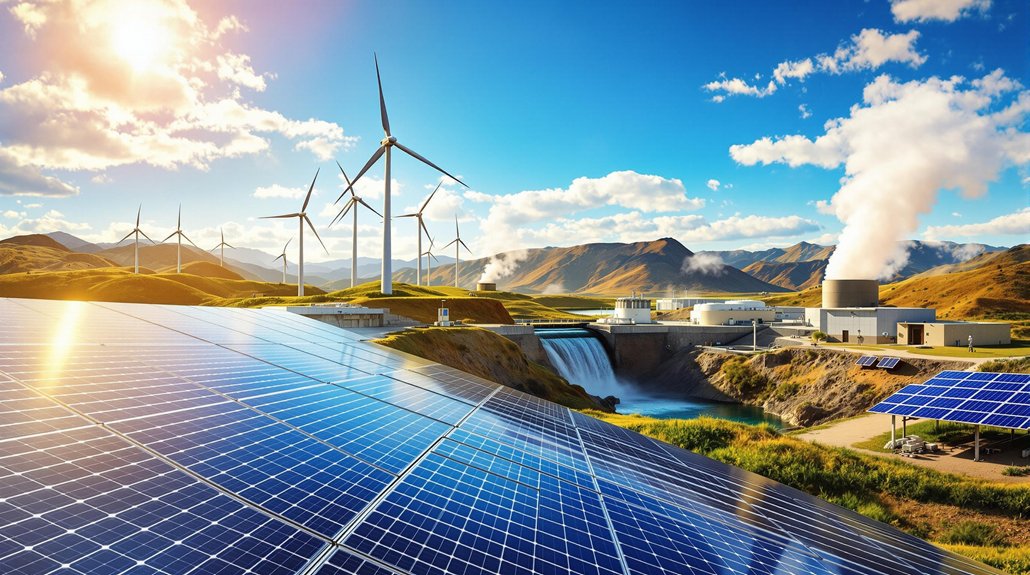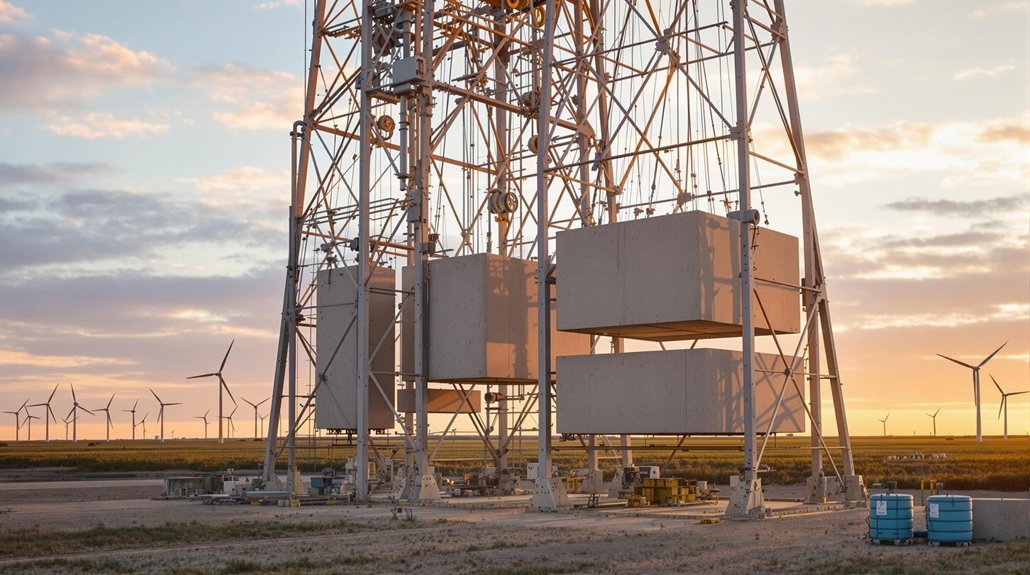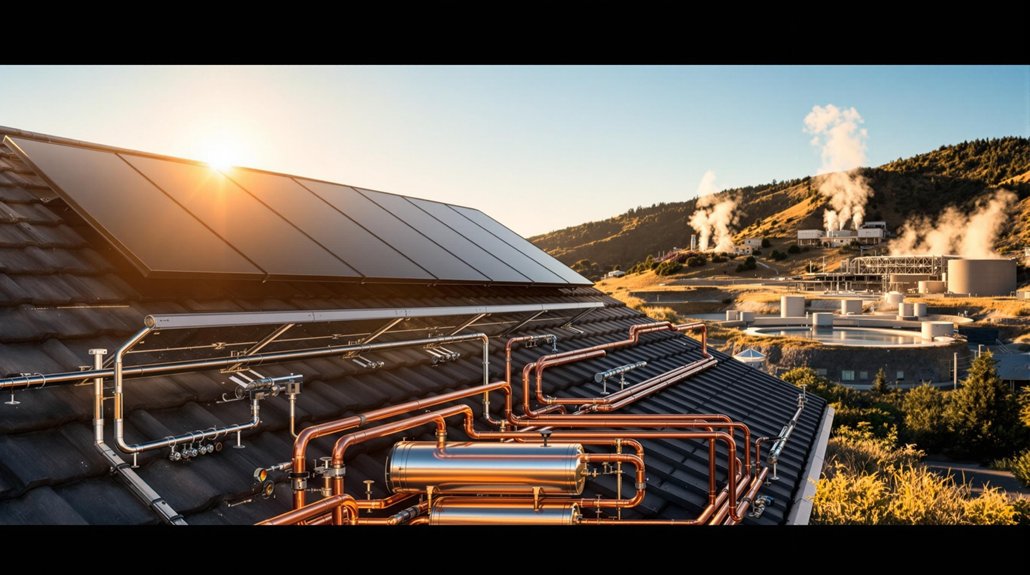Renewable energy sources harness naturally occurring power from sunlight, wind, water, and Earth’s heat. They’re clean alternatives to fossil fuels, producing minimal greenhouse gas emissions. Solar energy uses photovoltaic cells, while wind power captures moving air through turbines. Hydropower remains the largest renewable source globally, providing consistent electricity. Newer options include tidal energy and hydrogen fuel. These sustainable alternatives continue to improve in efficiency and cost-effectiveness as technology advances.

As the world seeks cleaner alternatives to fossil fuels, renewable energy sources are becoming increasingly important in the global energy mix. These sustainable options capture naturally occurring energy from sunlight, wind, water, and other sources that won’t run out. Each type offers unique benefits while helping reduce greenhouse gas emissions. These renewable sources are crucial for achieving sustainability and reducing dependence on non-renewable energy sources.
Solar energy stands out as the fastest growing renewable source globally. It uses photovoltaic cells to convert sunlight directly into electricity. These systems require minimal maintenance once installed and can be placed on rooftops or in large solar farms. Solar technology continues to improve in efficiency while costs drop rapidly.
Wind energy harnesses moving air to generate electricity through turbines. Both onshore and offshore wind farms contribute over 8% of U.S. electricity generation. Wind turbines typically need speeds exceeding 9 mph to produce power. The technology keeps advancing with larger, more efficient turbines. Modern turbines show remarkable technological improvements, with average sizes now ranging from 2 to 5 megawatts.
Hydropower remains the largest source of renewable electricity worldwide. It creates power from flowing water and provides 7.3% of U.S. electricity. Unlike some renewables, hydropower can supply consistent electricity 24/7 and offers energy storage through pumped systems.
Geothermal energy taps Earth’s internal heat for electricity and heating. It delivers stable, constant power with minimal land use and emissions. Though currently limited to areas with accessible heat resources, enhanced systems are expanding its potential reach.
Biomass energy converts organic matter like wood, crops, and waste into electricity, heat, and fuels. This versatile source contributes over 1.4% of U.S. electricity while reducing landfill waste through waste-to-energy plants. In 2023, biomass provided nearly five quadrillion Btu of energy in the United States, representing about 5% of total primary energy use.
Tidal energy captures predictable power from ocean movements based on lunar cycles. Despite high output potential, it’s limited to coastal areas and remains mostly in pilot stages.
Hydrogen represents another promising option, especially when produced through renewably powered electrolysis. It can store energy, provide heat, and fuel transportation with only water as a byproduct. While infrastructure is still developing, hydrogen shows potential for sectors difficult to electrify.
Frequently Asked Questions
How Do Renewable Energy Sources Impact Local Wildlife?
Renewable energy sources can harm wildlife in various ways.
Solar farms cause habitat loss and bird collisions.
Wind turbines kill over a million birds yearly and affect bats through collisions and pressure changes.
Hydropower dams block fish migration and flood habitats.
Biomass energy requires crops that reduce wildlife habitat and may introduce harmful chemicals.
However, proper siting and mitigation measures can greatly reduce these negative impacts.
What Are the Initial Installation Costs of Renewable Energy Systems?
Renewable energy installation costs vary widely.
Home solar systems range from $15,000-$25,000.
Commercial solar costs about $1.34 per watt.
Wind energy runs $1.3-$2.2 million per megawatt for onshore projects.
Hydropower installations cost between $1,000-$5,000 per kilowatt, depending on the site.
Geothermal systems typically require $2-$5 million per megawatt.
These costs continue to decline as technology improves and more systems are installed globally.
Can Renewable Energy Completely Replace Fossil Fuels?
Experts believe renewable energy can eventually replace fossil fuels.
Studies show it’s technically possible by 2050, with renewables already providing 30% of global electricity.
However, significant challenges remain. Energy storage solutions are needed for wind and solar intermittency. Some industries like aviation are difficult to electrify.
Success depends on technological advances, policy support, and massive infrastructure investments.
The shift timeline estimates range from 30 to 100+ years.
How Do Weather Patterns Affect Renewable Energy Reliability?
Weather patterns greatly impact renewable energy reliability.
Cloud cover reduces solar panel efficiency by 10-25%. Wind turbines can’t operate in too little or too much wind. Droughts limit hydropower generation. Extreme weather like hurricanes damages infrastructure.
That’s why forecasting is essential for planning. Energy companies use short-term forecasts for daily operations and long-term climate projections for infrastructure development.
Diversifying renewable sources helps manage these weather-related challenges.
What Incentives Exist for Homeowners Adopting Renewable Energy?
Homeowners can receive several incentives for adopting renewable energy. The federal government offers a 30% tax credit for residential solar systems through 2032.
Many states provide property tax exemptions and cash rebates. Some utilities offer performance-based incentives.
Homeowners can also access the Energy Efficient Home Improvement Credit of up to $1,200 annually.
Financing options include solar loans, PPAs, and green mortgages.









